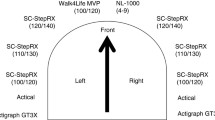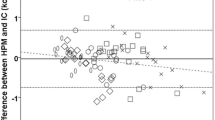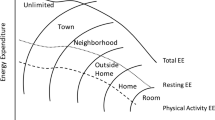Summary
The purpose of this study was a critical evaluation of pedometer and actometer for estimating daily physical activity.
Both instruments were tested for reliability on a carriage with movements in different directions. To obtain comparable data of different pedometers it was necessary to adjust the spring tension very carefully. The reliability of the individual actometer was satisfactory, but there are large differences between the watches. Therefore, a correction factor (C.F.) was introduced.
Some experiments were carried out on a treadmill. 9 Children (aged 5–6 years) and 6 young adult males (aged 21–31 years) walked and ran at different speeds. The energy expenditure was calculated from formulas. The pedometer overestimates the actual step rate with 0.1–0.3 counts per step during fast walking (6–9 km·h−1) and fast running (15 km·h−1). It underestimates the actual step rate with 0.2–0.7 counts per step, while walking slowly. It was shown that the pedometer does not reflect the differences in energy expenditure levels at different speed very well. The actometer units per step increases more or less proportional to the speed of walking and running. In contrast to the pedometer results the actometer results are more related to the energy expediture levels at different speed.
The results of this study suggest that the actometer might be a valid indicator of the daily physical activity in terms of energy expenditure.
Similar content being viewed by others
References
Edholm, O. G.: Assessment of the physical activity. In: Physical activity in health and disease (K. Evang, K. Andersen, eds.), p. 187. Oslo: Scan. University Book 1966
Hermans-Teluy, E. J., Binkhorst, R. A.: Walking or cycling — expenditure of energy as a basis for choice. Hartbulletin 5, 59 (1974)
Högberg, P.: Length of stride, stride frequency, “flight” period and maximal distance between the feet during running at different speed. Arbeitsphysiologie 14, 431 (1952)
Johnson, C. F.: Hyperactivity and the machine: the actometer. Child Develop. 42, 2105 (1971)
Lauter, S.: Zur Genese der Fettsucht. Dtsch. Arch. klin. Med. 150, 315 (1926)
Macke, R. W., Kleinhenz, M. E.: Growth, Caloric intake and activity levels in early infancy: A preliminary report. Hum. Biol. 46, 345 (1974)
Marsden, J. P., Montgomery, S. R.: A general survey of the walking habits of individuals. Ergonomics 4, 439 (1972)
Massey, D. A., Lieberman, A., Batarseh, G.: Measure of activity level in mentally retarded children and adolescents. Amer. J. ment. Defic. 76, 259 (1971)
Reed, J. D.: Spontaneous activity in animals. Psychol. Bull. 44, 393 (1974)
Rose, H. E., Mayer, J.: Activity, caloric intake, fat storage and the energy expenditure balance of infants. Pediatrics 41, 18 (1968)
Schulman, J. L., Reisman, J. M.: An objective measure of hyperactivity. Amer. J. ment. Defic. 64, 455 (1959)
Silverman, M., Anderson, S. D.: Metabolic cost of treadmill exercise in children. J. Appl. Physiol. 33, 696 (1972)
Staveren, W. A. van: Pedometer and actometer as device for measuring energy expenditure. Msc. Thesis, University of London 1974
Stunkard, A.: A method of studying physical activity in man. Amer. J. clin. Nutr. 8, 595 (1960)
Author information
Authors and Affiliations
Rights and permissions
About this article
Cite this article
Saris, W.H.M., Binkhorst, R.A. The use of pedometer and actometer in studying daily physical activity in man. Part I: Reliability of pedometer and actometer. Europ. J. Appl. Physiol. 37, 219–228 (1977). https://doi.org/10.1007/BF00421777
Accepted:
Issue Date:
DOI: https://doi.org/10.1007/BF00421777




